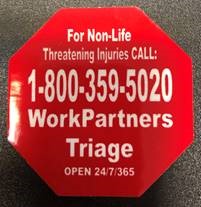Did you know construction sites are one of the highest risk places for fire? Here we share some simple tips that can help prevent fires starting on your sites.
First, let’s consider why construction sites, in particular, are at an increased risk of fire. This increased risk of fire is due to a variety of factors.
- The presence of flammable waste materials
- The use of flammable and explosive substances like gases and solvents
- The type of work activities including hot works processes and incomplete electrical systems
- There is an increased risk of vandalism, trespass and malicious acts
- The nature of the unfinished building
- The storage of building materials on site which are often flammable increases the damage caused once a fire does take hold, and can also pose increased risks to fire and rescue teams
Fire prevention must, therefore, be a top priority when planning and managing construction work.
Before and during your use of a fire extinguisher:
- Stay calm and activate the fire alarm to alert others
- Contact site management and Call 9-1-1
- Identify a partner to watch your back while you use the fire extinguisher (with PASS method) and ensure that heat, smoke, fire or other dangers do not block your escape
- When using the extinguisher, attack the fire in the direction of the wind as to not breathe in the ABC powder and smoke
- Proceed on your clear evacuation route to muster point if you cannot extinguish the fire
What is PASS?
When using a fire extinguisher:
- PULL the retaining pin on the handle of the fire extinguisher Stand back 8-10 feet from the fire
- AIM the nozzle of the extinguisher at the base of the fire
- SQUEEZE the handle of the extinguisher
- SWEEP the extinguishing agent at the base of the fire
Portable fire extinguishers will generally be labeled with the symbols for the types of fires they are designed to extinguish A, B, C, D , K or ABC.
Safety Tips
- Don’t block the fire extinguisher(s) by equipment or debris; keep access clear at all times
- Reduce and/or eliminate fire sources; never attempt to dispose of rubbish by burning it
- Site ‘bonfires’ are forbidden as they can get out of control easily
- Evaluate fire size: Don’t use more than two extinguishers on a fire
- If a fire requires more than two extinguishers, it means the fire is too big—evacuate immediately
- Note: This is generally the size of a medium size trash can
- Plan for waste: Keeping your site clear is one thing, but waste has to go somewhere
- Plan designated areas for waste with fire and emergency procedures in place to confine and deal with a fire should it break out
- Note: Ideally skips and other waste containers should be away from the site boundary to reduce the risk of arson, and away from buildings and storage of flammable substances
- Hot Work Permits: Permits and fire watch are required for all work that creates a spark or open flame within 25’ flammable materials
- Fire watch should have their own dedicated fire extinguisher (not using the general sites)
- Quantity: Ensure that there is adequate quantity of fire extinguishers for the are you are working
- Know the surrounding: Don’t attempt to extinguish fires that are in a flammable liquids storage area, in an explosives vault or near a liquid propane tank
Courtesy of Garco.
Remember to call WorkPartners with any non-life threating injury 24/7/365.

